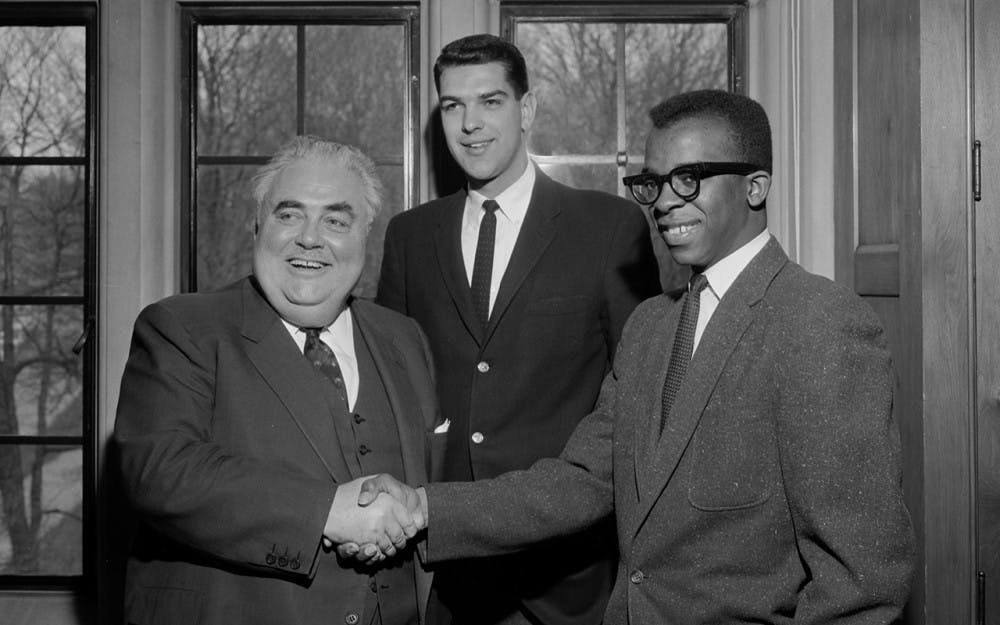Similar to how some in the United States saw former President Barack Obama’s election as a symbol of progress for black Americans, the election of Thomas Atkins in 1960 as the first black student body president in the Big Ten Conference was a landmark event.
Also similar to Obama’s election, Atkins’ presidency was not the end of civil rights debate on campus, as protests in the late 1960s demonstrated how black students still felt disenfranchised by IU’s administration.
In the wake of the Rev. Martin Luther King Jr.’s assassination in 1968, protests on campus escalated and culminated in a sit-in the at the racetrack a day before the Little 500 bike race was to begin. Protesters, led by graduate student Clarence “Rollo” Turner, camped out at the stadium and demanded campus greek organizations amend their charters to include black students.
At the time, IU President Elvis Stahr asked the greek organizations to comply. All but one organization — the exception was Phi Delta Theta — did so. The national office would not submit to requests for integration. The decision not to allow the organization to race was one made by the administration, according to a statement from Stahr.
The event is documented in Mary Ann Wynkoop’s book “Dissent in the Heartland: The Sixties at Indiana University.”
“The point has been made here that black students can come together as a group of black people, stay together as a group of black people, can make a point as black people,” Turner said after Stahr agreed to meet his demands, according to the book. “It is time to go home.”
While this happened on campus, Atkins was serving as a Boston City Council member. Atkins would later be credited with helping to prevent riots in the wake of King’s assassination.
The Little 500 sit-in was not the end to Turner’s involvement in campus affairs.
University Archives show his involvement in the following year’s protests regarding a tuition fee hike. On the evening of May 8, 1969, Turner and other students locked faculty and administrators into a lounge in Ballantine Hall and demanded to speak to members of the Board of Trustees.
Newspaper headlines characterized the protest as a hostage situation. In a May 9 article in the Bloomington Courier-Tribune titled “Black students hold IU officials hostage,” the newspaper said “the officials were held hostage by about 140 negro students inside the room who guarded windows and doors.”
A statement from the faculty and administrators disputed this characterization as merely a hostage situation. While they condemned any act of violence, the political climate required them to investigate each situation individually.
“As the situation evolved, small group discussions developed which in our judgement resulted in increased understanding,” the faculty wrote in the statement.
A dozen students and former faculty members, including Turner, would be charged for the Ballantine Hall lock-in. The final members of the group were acquitted in August 1971, according to newspaper clippings in the University Archives.
The Louisville Courier-Journal & Times reported Indiana Gov. Edgar Whitcomb woke up in the middle of the protest, which occurred late in the evening, to be informed that students planned to harm the University’s Acting Chancellor, John Snyder.
Joseph Sutton, then the University’s president, wrote in a personal letter held by the IU Archives his fears about the protest.
“Rollo always says he is willing to die,” Sutton wrote of Turner. “Nobody has made a threat but if you call in force I don’t know what they might do.”
A photo of Snyder in the Indiana Daily Student the next day shows him exchanging remarks with a helmet-clad student. In the photo, the two are grinning.
Snyder would eventually resign from his position in June. In his open letter to the campus, he cited increasing levels of political and social unrest on college campuses and increased availability to pornography as major issues facing institutes of higher learning.
The end of the ‘60s did not mark the end of racial discourse on campus. Records show unrest following a 1971 arrest of two black female students in the library for speaking too loudly.
However, the climate on campus throughout the ‘60s, though not distinct to IU, was a decisive period of relationship between black students and the school’s administration.
Up until present day, including this academic year when protests occurred on an almost weekly basis, IU has been a platform for social discourse.





